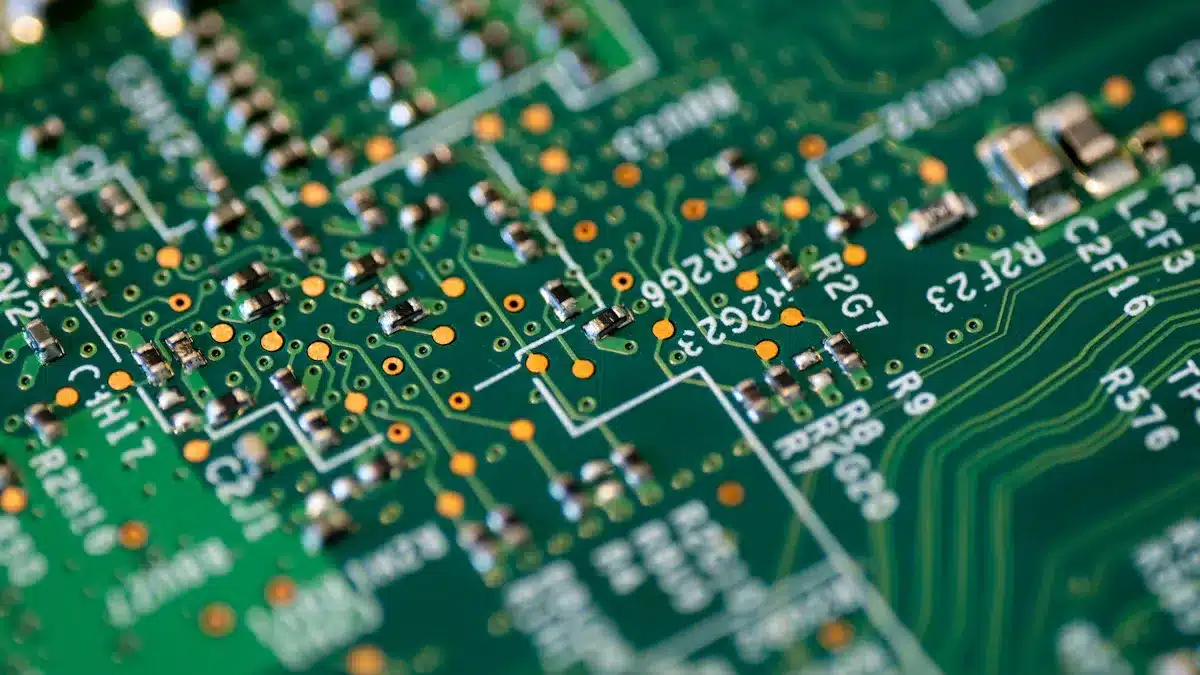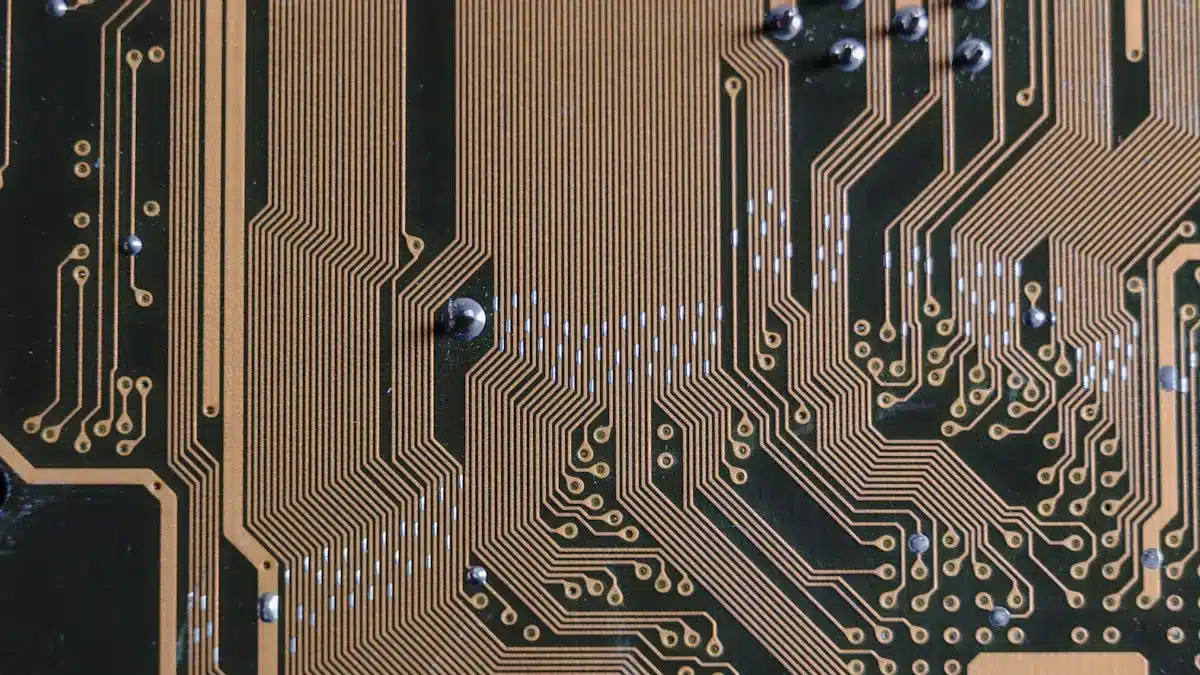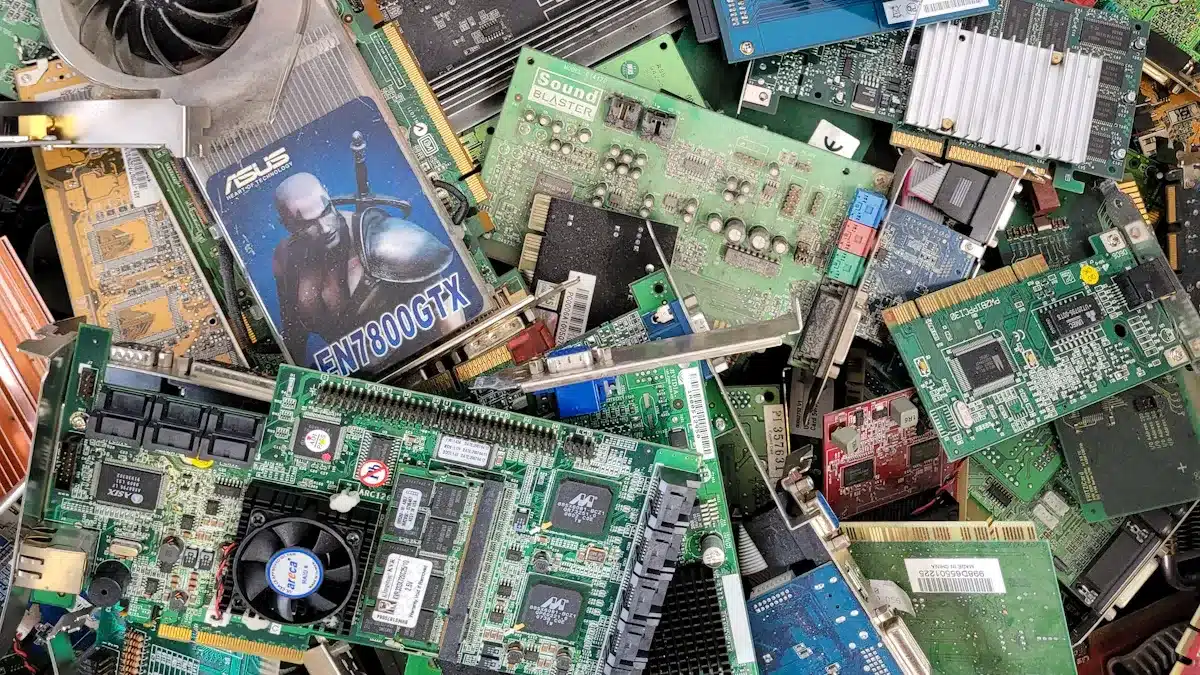
You often see the term meaning pcb in electronics. A printed circuit board is a thin base that does not conduct electricity. It has copper lines that link electronic parts. PCBs let signals move on the board and do jobs like computing. They also keep parts safe from each other. Knowing the meaning pcb helps you see how each circuit board helps new technology grow.
PCBs are the main place to put and join parts in devices.
Circuit boards are very important for safe and steady electronics.
Key Takeaways
A PCB is a flat board. It holds and connects electronic parts. It uses copper lines to do this. This helps devices work safely. It also makes them work well.
PCBs can have one, two, or many layers. Each type is made for different devices. Some are for simple gadgets. Others are for more complex electronics.
It is important to know the difference between a PCB and a PCBA. A PCB is just the empty board. A PCBA is a board with parts on it. This helps you see how devices are made and work.
Meaning PCB

Printed Circuit Board
You might ask what meaning pcb means in electronics. PCB stands for printed circuit board. It is a flat board made from fiberglass or epoxy. This board does not let electricity pass through it. On top, there are thin copper lines. These lines connect different parts of a device. When you look at a circuit board, you see copper lines and small metal holes called vias. These help signals move between parts.
People in the industry use printed circuit board for boards with copper lines and parts. Sometimes, people say printed wiring boards. This is an old name for boards with simple wires. Today, most people use printed circuit board or PCB. PCB is now the main word everywhere. Printed wiring boards is only used in a few places.
Note: PCB means printed circuit board. It is the main board that connects and holds parts in almost every device you use.
PCB Structure
A printed circuit board has layers. Each layer does something special. The main layers are:
Substrate: This is the bottom layer. Most PCBs use fiberglass (FR-4) for strength and safety.
Copper Layer: Thin copper foil makes paths for electricity. Some boards have copper on one side, both sides, or many layers.
Solder Mask: This green or other color layer covers the copper. It keeps copper safe and stops short circuits.
Silkscreen: This layer adds words and symbols to help you find and place parts.
Here is a table to show the differences in PCB types and materials:
PCB Type | Layers Description | Materials Used |
|---|---|---|
Single-layer PCB | One side of fiberglass/epoxy substrate laminated with copper foil | Fiberglass/epoxy substrate (FR-4), copper foil |
Double-layer PCB | Fiberglass/epoxy substrate with copper foil laminated on both sides | Fiberglass/epoxy substrate (FR-4), copper foil |
Multi-layer PCB | Multiple double-sided boards laminated together with prepreg layers in between | Fiberglass/epoxy substrate (FR-4), copper foil, prepreg layers |
Other important materials in printed circuit boards are:
Prepreg: This sticky fiberglass layer holds other layers together.
Surface finishes: These coatings protect copper pads and help with soldering.
Solder mask: This layer keeps copper safe from air and water.
The way a circuit board is built lets you put many parts close together. You can use single-layer boards for easy devices. You can use multi-layer boards for hard or complex electronics.
Function in Electronics
The main job of a printed circuit board is to hold and connect electronic parts. You put things like resistors, capacitors, and chips on the board. You solder them to copper pads. The copper lines act like roads for electricity. They let signals move between parts so your device works.
Printed circuit boards do more than just connect parts. They also:
Help move heat away from hot parts.
Keep signals strong and clear.
Make devices smaller and work better.
Here is a quick table about what a PCB does in your device:
Function | Description |
|---|---|
Electrical Connectivity | Connects all parts so signals and power can flow. |
Mechanical Support | Holds and protects electronic components. |
Signal Integrity | Keeps signals strong and clear. |
Thermal Management | Moves heat away from parts to keep them cool. |
Compact Design | Allows for small, powerful devices. |
Cost-Effective Production | Makes it easier and cheaper to build many devices. |
You may also hear about PCBA. This means printed circuit board assembly. A PCB is just the empty board with copper lines. It cannot do anything alone. When you add and solder all the parts, it becomes a PCBA. Now, the board can work in your device.
Tip: Remember, PCB is the empty board. PCBA is the finished board with all parts on it and ready to use.
The meaning pcb is important if you want to know how electronics work today. You see printed circuit boards in computers, phones, cars, and many other things. Knowing the difference between PCB, PCBA, and printed wiring boards helps you talk about electronics with confidence.
Types of Boards

Printed Circuit Boards
You will find three main types of pcbs in most electronic devices. Each type has its own structure and use:
Single-sided pcb: This board has copper on one side. You see it in simple products like calculators and LED lights. It is easy to make and costs less.
Double-sided pcb: This board has copper on both sides. Small holes called vias connect the two sides. You find these boards in car dashboards, vending machines, and phone systems.
Multilayer pcb: This board has three or more copper layers. It supports complex circuits. You see it in computers, smartphones, and medical devices.
Here is a table to help you compare these boards:
PCB Type | Structure & Layers | Main Uses |
|---|---|---|
Single-sided | Copper on one side | Calculators, TVs, LED displays |
Double-sided | Copper on both sides, vias connect | Industrial controls, power units |
Multilayer | Three or more copper layers laminated | Computers, smartphones, servers |
Layers and Materials
The layers and materials in a pcb affect how well it works. Most printed circuit boards use FR-4, a strong fiberglass material. Some boards use metal or ceramic for better heat control. Flexible boards use polyimide so you can bend them. The number of layers helps you fit more parts and signals in a small space. More layers mean better performance but also higher cost.
PCB vs PCBA
A pcb is just the empty circuit board with copper lines. It cannot work by itself. When you add and solder all the electronic parts, you get a pcba. This finished board can run your device. You see pcbas in smartphones, laptops, cars, and medical machines. Printed circuit board assemblies protect parts from dust and heat. They also help your device last longer. You use bare pcbs for testing or building new projects. You use pcbas in real products that need to work every day.
Tip: Remember, a pcb is the base. A pcba is the finished board ready for use in your electronic device.
You can see that a pcb helps parts work together. It makes devices work well and not break easily. The table below shows why learning about pcb is important for people who like technology. If you learn about these boards, you get new skills. These skills help you invent things and find good jobs.
Aspect | Key Point |
|---|---|
Definition | PCB connects and supports components |
Benefits | Miniaturization, reliability, mass production |
Applications | Consumer, automotive, medical, industrial |
FAQ
What is the main difference between a PCB and a PCBA?
You use a PCB as a base for parts. When you add and solder parts, you get a PCBA that works in your device.
Can you reuse a printed circuit board?
You can reuse a printed circuit board if you remove old parts carefully. Make sure the copper lines and pads stay in good shape.
Are printed wiring cards and printed circuit boards the same?
You may hear people say printed wiring cards. This term means the same thing as printed circuit boards in most cases.
See Also
Understanding PCB Design And Its Importance In Electronics
Exploring PCBA Meaning And Its Function Within Electronics
Defining PCBA And Its Significance In Electronic Systems